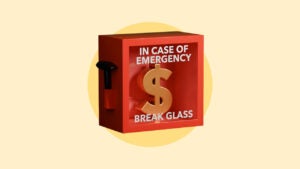5 steps to take in a financial emergency

Financial emergencies can happen to anyone at any time, and they can be very stressful to deal with. Whether it’s unexpected medical bills, job loss, or a major home repair, financial emergencies can quickly throw your finances into chaos.
Over a third (38 percent) of U.S. households had reported experiencing serious financial problems within 2021, according to a 2021 study conducted by NPR, the Robert Wood Johnson Foundation and the Harvard T. H. Chan School of Public Health. Inability to pay debt and afford medical care were the two most commonly reported financial issues.
With the potential of a recession within the next year and a projected increase in unemployment, it’s especially important to know what to expect in case you face a sudden loss of income.
If you’ve found yourself in a financial emergency, or want to know what to prepare for when an emergency arises, here are the steps to take and resources that can help you navigate through financial hardships.
1. Assess your financial situation
Before you can take any action, you need to know exactly what impact the emergency will take on your finances and what parts of your budget are affected. Make a list of all the bills and expenses that need to be covered. This will help you determine the total amount of money you will need to spend from your emergency fund, or how much funds you need to source from elsewhere and when you’ll need it.
Consider what resources you already have to make up for financial losses. Do you have an emergency fund or other savings that you can tap into? Are there any assets that you can sell to help cover the costs? Having a complete inventory of your finances can lend clarity to your needs and help assuage some of the anxiety that might come from the emergency.
2. Prioritize expenses
Next, you’ll need to evaluate your budget and expenses. If you don’t already have them organized in a budget, start by making a list of all your bills and expenses, then rank them in order of urgency and importance. Essential expenses, like rent or mortgage payments, utilities and food, should take priority over nonessentials, like entertainment and clothing.
You might need to give up some pleasures you took for granted previously that end up at the lower end of your priorities. Canceling subscription services that you don’t really need, cooking at home and staying in more nights of the week are ways that you can make your expenses simpler and focus on meeting the essentials.
3. Contact creditors and lenders
If you’re unable to meet your financial obligations, contact your creditors and lenders as soon as possible.
Notify them of your situation and request a payment plan or forbearance. It’s best to be transparent — explain honestly why you’re struggling to make loan or credit payments and provide any relevant information or documentation that supports your case.
If your creditors and lenders are willing to work with you, negotiate the terms of the payment plan or forbearance to make payments realistic to your circumstances. A payment plan allows you to spread out your payments over a longer period of time, while forbearance allows you to temporarily pause or reduce your payments.
4. Explore additional sources of income
Look for additional sources of income to help hold you over through the financial emergency. You might want to consider taking on a part-time job, if that’s a viable option.
Another way to generate extra income is to sell unused items. Look around your home for items that you no longer need or use and consider selling them on an online marketplace or at a yard sale.
Instead of applying for a part-time job, it might be easier to find side gigs, such as freelancing gigs. Unlike a standard job, side gigs are much more flexible, allowing you to choose when you want to take on work and what kind of work you want to do. Many of these gigs are catered to a specific niche that’s aligned with your skills, interests and abilities, whether that be freelance writing or helping people move stuff.
Finally, you could look into government assistance programs, such as unemployment benefits, the Supplemental Nutrition Assistance Program (SNAP) or Temporary Assistance for Needy Families (TANF). If you’ve experienced a job loss or other financial hardship, you could be eligible for one of these programs that are designed to provide temporary financial assistance to those in need.
5. Seek professional help
Don’t be afraid to reach out for professional help if you find yourself still struggling to make ends meet. Financial advisors and counselors can help you identify areas where you can cut expenses, develop a plan to pay off debt and create a realistic budget to continue making headway on your financial goals.
Look for a financial advisor or credit counselor through an organization that’s accredited by a recognized authority, such as the National Foundation for Credit Counseling or the Financial Industry Regulatory Authority. You could also ask friends, family members or colleagues for referrals to advisors they’ve worked with and trust. Remember that banks may offer financial advising, too.
Many counselors offer free initial consultations, so take advantage of this to learn more about their services and approach. Some financial organizations, including the Financial Planning Association, also offer pro bono counseling for people affected by financial crises.
Resources for different financial emergencies
There are resources available to help you through a financial emergency. Here are some common types of financial emergencies and where you can get assistance for each.
Medical emergency
- Payment plans or financial assistance programs through the hospital or medical provider
- Nonprofit organizations, such as the Patient Advocate Foundation and HealthWell Foundation
- Disability benefits, if the medical emergency results in a loss of income
Job loss
- Unemployment benefits through your state’s unemployment insurance program
- CareerOneStop, a resource sponsored by the U.S. Department of Labor that offers free job training, guides and job search
- TaskRabbit, an online service that connects you to locals seeking out paid help with a variety of needs, from furniture assembly to painting
Natural disaster
- Assistance through the Federal Emergency Management Agency (FEMA)
- Nonprofit organizations and local community groups, such as the Red Cross
Identity theft
- Identity Theft Resource Center (ITRC), which provides free assistance to identity theft victims
- IdentityTheft.gov, which offers free recovery plans for victims
- Victim compensation programs through your state
Other resources
- Temporary Assistance for Needy Families (TANF)
- Low Income Home Energy Assistance Program (LIHEAP), which provides emergency funds to help cover utility costs
- Feeding America, a nonprofit that provides emergency food assistance
- Personal finance apps, which can help you establish a budget and find where to cut down on expenses
Bottom line
Financial emergencies can be overwhelming, but taking the steps outlined above can help you navigate through a difficult time. Prioritize your expenses, negotiate with lenders and seek professional help to reduce the overall burden on your budget. And don’t hesitate to explore the many programs and resources available to provide emergency assistance.
Preparation is key to pulling through emergencies, so make sure to establish an emergency fund and regularly review your budget and financial situation.
Why we ask for feedback Your feedback helps us improve our content and services. It takes less than a minute to complete.
Your responses are anonymous and will only be used for improving our website.






